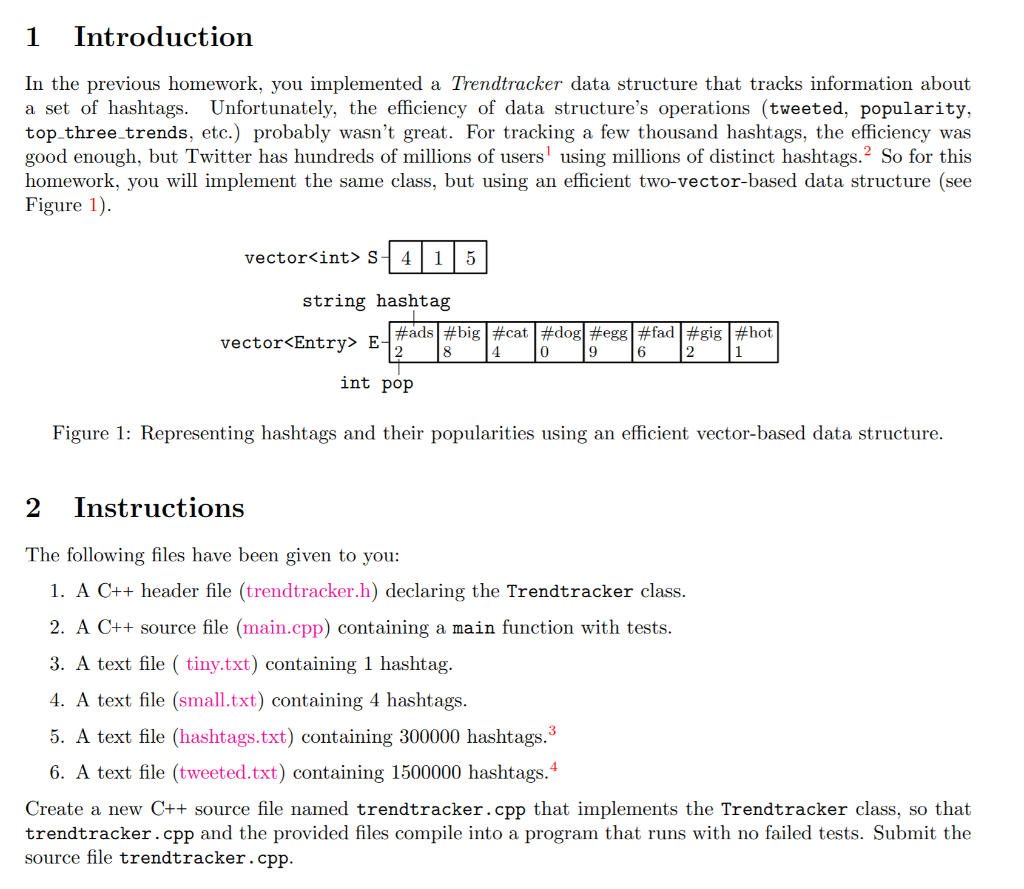Question
trendtracker.h (header) #ifndef TRENDTRACKER_H #define TRENDTRACKER_H #include #include #include #include using namespace std; class Trendtracker { // For the mandatory running times below: // n

trendtracker.h (header)
#ifndef TRENDTRACKER_H #define TRENDTRACKER_H
#include
using namespace std;
class Trendtracker { // For the mandatory running times below: // n is the number of hashtags in the Trendtracker.
public: // Creates a Trendtracker containing hashtags // found in the provided file. // The file is promised to have the following format: // // string1 // string2 // ... // stringN // // where string1
// Return the number of hashtags in the Trendtracker. // // Must run in O(1) time. int size();
// Adds 1 to the total number times a hashtag has been tweeted. // If the hashtag does not exist in TrendTracker, does nothing. // // Must run in O(log(n)) time. void tweeted(string ht);
// Returns the number of times a hashtag has been tweeted. // If the hashtag does not exist in Trendtracker, returns -1. // // Must run in O(log(n)) time. int popularity(string name);
// Returns a most-tweeted hashtag. // If the Trendtracker has no hashtags, returns "". // // Must run in O(1) time. string top_trend();
// Fills the provided vector with the 3 most-tweeted hashtags, // in order from most-tweeted to least-tweeted. // // If there are fewer than 3 hashtags, then the vector is filled // with all hashtags (in most-tweeted to least-tweeted order). // // Must run in O(1) time. void top_three_trends(vector
private: // A simple class representing a hashtag and // the number of times it has been tweeted. class Entry { public: string hashtag; int pop; };
// Optional helper method. // Returns the index of E containing an Entry with hashtag ht. // If no such hashtag is found, returns -1. // // Should run in O(log(n)). int search(string ht);
// Entries sorted (lexicographically) by hashtag. vector
// Stores indices of the (up to) three most-tweeted // entries in E. vector
#endif
- - - - - - - - - - - - - - - - - - - - - - - - - - - - - -
main.cpp
#include
using namespace std;
inline void _test(const char* expression, const char* file, int line) { cerr
#define test(EXPRESSION) ((EXPRESSION) ? (void)0 : _test(#EXPRESSION, __FILE__, __LINE__))
int main() { // Setup vector
// Test constructor, size(), popularity(), tweeted() Trendtracker T1("small.txt"); test(T1.size() == 4); test(T1.popularity("#algorithms") == 0); test(T1.popularity("#cs4all") == 0); test(T1.popularity("#datastructures") == -1); test(T1.popularity("#programming") == 0); test(T1.popularity("#C++") == 0);
T1.tweeted("#programming"); test(T1.popularity("#algorithms") == 0); test(T1.popularity("#cs4all") == 0); test(T1.popularity("#datastructures") == -1); test(T1.popularity("#programming") == 1); test(T1.popularity("#C++") == 0);
T1.tweeted("#programming"); test(T1.popularity("#algorithms") == 0); test(T1.popularity("#cs4all") == 0); test(T1.popularity("#datastructures") == -1); test(T1.popularity("#programming") == 2); test(T1.popularity("#C++") == 0);
T1.tweeted("#programming"); test(T1.popularity("#algorithms") == 0); test(T1.popularity("#cs4all") == 0); test(T1.popularity("#datastructures") == -1); test(T1.popularity("#programming") == 3); test(T1.popularity("#C++") == 0);
T1.tweeted("#cs4all"); test(T1.popularity("#algorithms") == 0); test(T1.popularity("#cs4all") == 1); test(T1.popularity("#programming") == 3); test(T1.popularity("#C++") == 0);
T1.tweeted("#algorithms"); test(T1.popularity("#algorithms") == 1); test(T1.popularity("#cs4all") == 1); test(T1.popularity("#datastructures") == -1); test(T1.popularity("#programming") == 3); test(T1.popularity("#C++") == 0);
T1.tweeted("#cs4all"); test(T1.popularity("#algorithms") == 1); test(T1.popularity("#cs4all") == 2); test(T1.popularity("#datastructures") == -1); test(T1.popularity("#programming") == 3); test(T1.popularity("#C++") == 0);
T1.tweeted("#datastructures"); test(T1.popularity("#algorithms") == 1); test(T1.popularity("#cs4all") == 2); test(T1.popularity("#datastructures") == -1); test(T1.popularity("#programming") == 3); test(T1.popularity("#C++") == 0);
Trendtracker T2("small.txt"); T2.tweeted("#programming"); T2.tweeted("#programming"); T2.tweeted("#programming"); T2.tweeted("#programming"); T2.tweeted("#programming"); T2.tweeted("#C++"); T2.tweeted("#C++"); T2.tweeted("#C++"); T2.tweeted("#C++"); T2.tweeted("#cs4all"); T2.tweeted("#cs4all"); T2.tweeted("#cs4all"); T2.tweeted("#algorithms"); T2.tweeted("#algorithms"); test(T2.popularity("#algorithms") == 2); test(T2.popularity("#cs4all") == 3); test(T2.popularity("#programming") == 5); test(T2.popularity("#C++") == 4);
// Enforce no usage of global variables test(T1.popularity("#algorithms") == 1); test(T1.popularity("#cs4all") == 2); test(T1.popularity("#programming") == 3); test(T1.popularity("#C++") == 0);
// Test top_trend(), top_three_trends() Trendtracker T3("small.txt"); T3.top_three_trends(R); test(R.size() == 3);
T3.tweeted("#programming"); test(T3.top_trend() == "#programming"); T3.top_three_trends(R); test(R.size() == 3); test(R[0] == "#programming");
T3.tweeted("#C++"); T3.tweeted("#C++"); test(T3.top_trend() == "#C++"); T3.top_three_trends(R); test(R.size() == 3); test(R[0] == "#C++"); test(R[1] == "#programming");
T3.tweeted("#algorithms"); T3.tweeted("#algorithms"); T3.tweeted("#algorithms"); test(T3.top_trend() == "#algorithms"); T3.top_three_trends(R); test(R.size() == 3); test(R[0] == "#algorithms"); test(R[1] == "#C++"); test(R[2] == "#programming");
T3.tweeted("#cs4all"); T3.tweeted("#cs4all"); T3.tweeted("#cs4all"); T3.tweeted("#cs4all"); test(T3.top_trend() == "#cs4all"); T3.top_three_trends(R); test(R.size() == 3); test(R[0] == "#cs4all"); test(R[1] == "#algorithms"); test(R[2] == "#C++");
// At this point: // cs4all: 4 // algorithms: 3 // C++: 2 // programming: 1
T3.tweeted("#programming"); T3.tweeted("#programming"); T3.tweeted("#programming"); T3.tweeted("#programming"); test(T3.top_trend() == "#programming"); T3.top_three_trends(R); test(R.size() == 3); test(R[0] == "#programming"); test(R[1] == "#cs4all"); test(R[2] == "#algorithms");
// At this point: // programming: 5 // cs4all: 4 // algorithms: 3 // C++: 2
T3.tweeted("#cs4all"); T3.tweeted("#cs4all"); T3.tweeted("#algorithms"); test(T3.top_trend() == "#cs4all"); T3.top_three_trends(R); test(R.size() == 3); test(R[0] == "#cs4all"); test(R[1] == "#programming"); test(R[2] == "#algorithms");
// At this point: // cs4all: 6 // programming: 5 // algorithms: 4 // C++: 2
for (int i = 0; i
Trendtracker T4("hashtags.txt"); test(T4.size() == 300000);
ifstream f; f.open("tweeted.txt"); assert(f.is_open()); // If this fails, you're missing tweeted.txt while (getline(f, line)) T4.tweeted(line); f.close();
test(T4.popularity("#programming") == 10); test(T4.popularity("#computer") == 9); test(T4.popularity("#is") == 8); test(T4.popularity("#very") == 7); test(T4.popularity("#fun") == 6); test(T4.popularity("#but") == 5); test(T4.popularity("#sometimes") == 5); test(T4.popularity("#can") == 5); test(T4.popularity("#be") == 5); test(T4.popularity("#challenging") == 5);
test(T4.top_trend() == "#programming");
T4.top_three_trends(R); test(R[0] == "#programming"); test(R[1] == "#computer"); test(R[2] == "#is");
// Test a Trendtracker with a single hashtag Trendtracker T5("tiny.txt"); test(T5.size() == 1); test(T5.popularity("#solo") == 0); test(T5.popularity("#duo") == -1); T5.tweeted("#solo"); test(T5.popularity("#solo") == 1); test(T5.popularity("#duo") == -1); test(T5.top_trend() == "#solo"); T5.top_three_trends(R); test(R.size() == 1); test(R[0] == "#solo");
cout 1 Introduction In the previous homework, you implemented a Trendtracker data structure that tracks information about a set of hashtags. Unfortunately, the efficiency of data structure's operations (tweeted, popularity, top_three_trends, etc.) probably wasn't great. For tracking a few thousand hashtags, the efficiency was good enough, but Twitter has hundreds of millions of users using millions of distinct hashtags. So for this homework, you will implement the same class, but using an efficient two-vector-based data structure (see Figure 1). vector
Step by Step Solution
There are 3 Steps involved in it
Step: 1

Get Instant Access to Expert-Tailored Solutions
See step-by-step solutions with expert insights and AI powered tools for academic success
Step: 2

Step: 3

Ace Your Homework with AI
Get the answers you need in no time with our AI-driven, step-by-step assistance
Get Started


